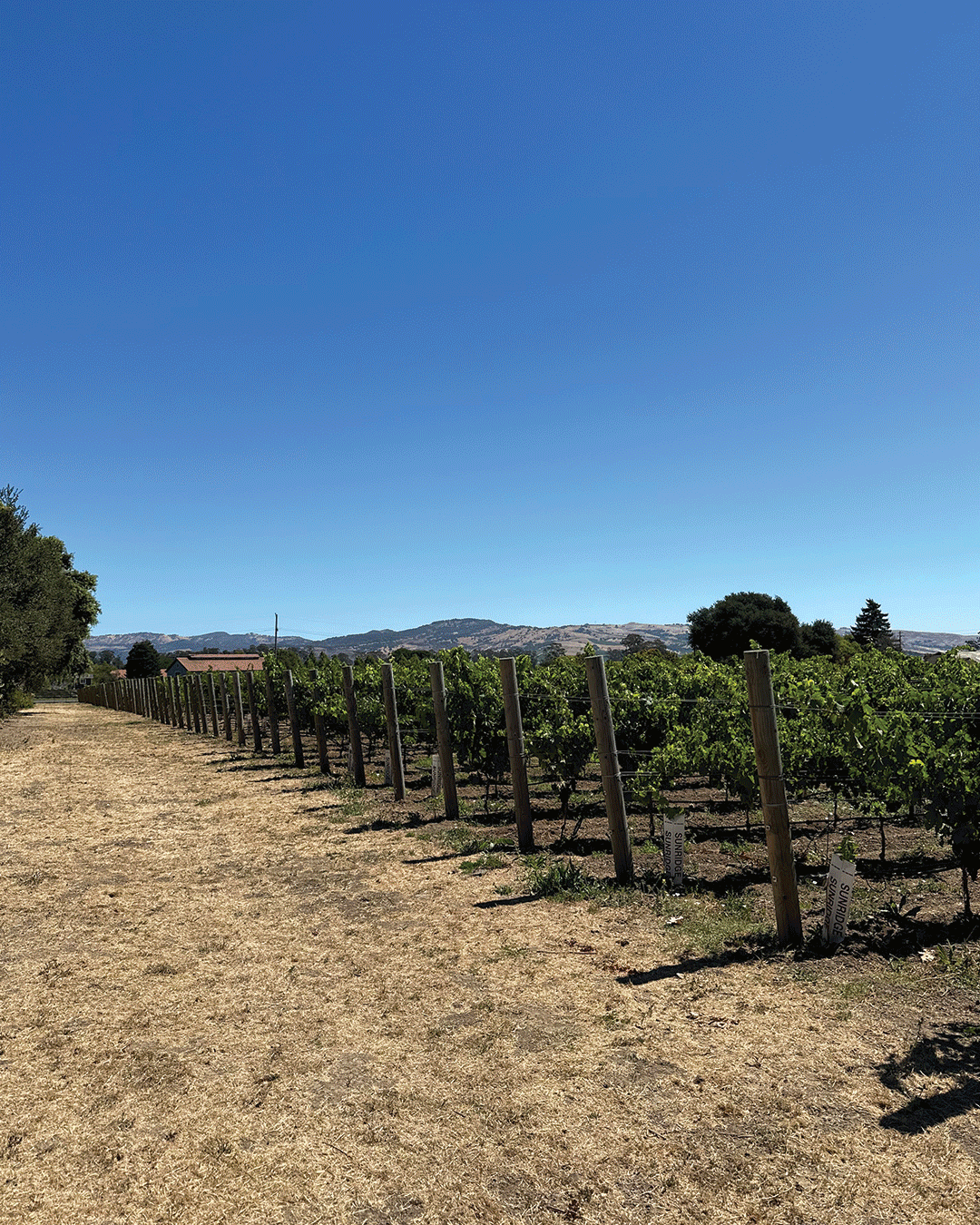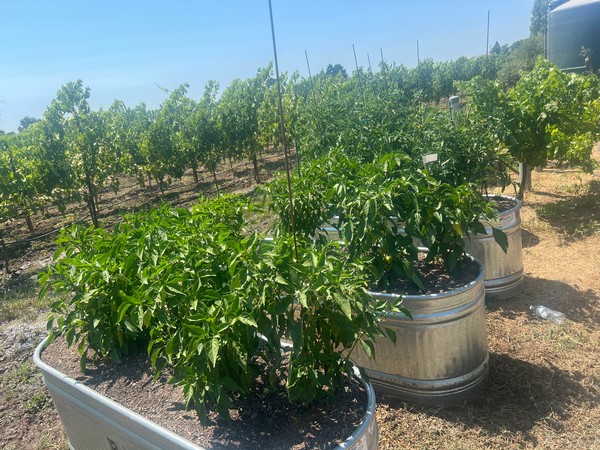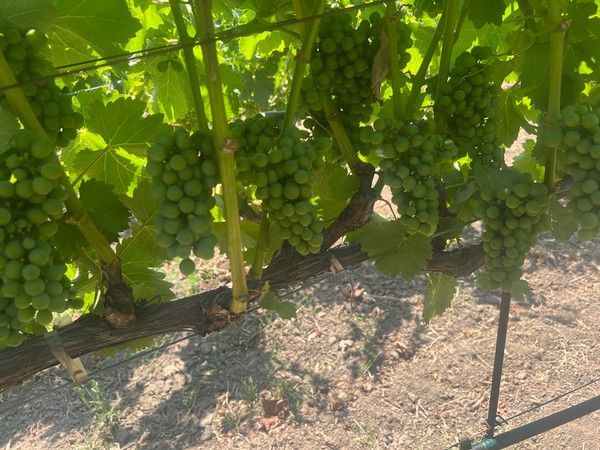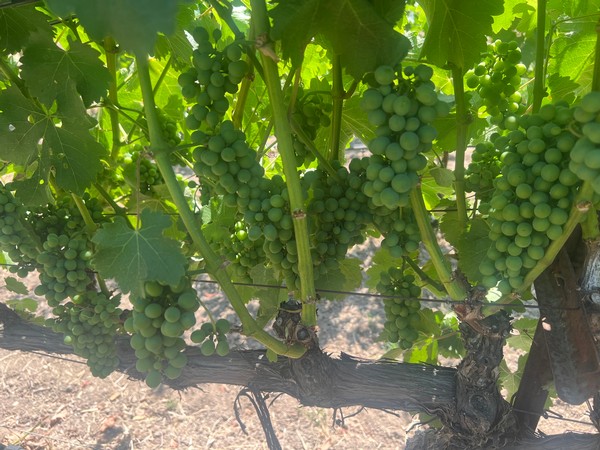News, reviews, and updates from the estate.
Vineyard updates:

Things are moving fast these days at the vineyard. The reds are nearing completion of veraison, the Sauvignon Blanc is sugaring up, olives are fleshing out, and the roses are in bloom. Trino and I have been going through the vineyard daily to drop green fruit from the Cabernets and the Merlot, space out the clusters, do a little final leaf pulling on some of the more overgrown vines -- generally just trying to clean things up as much as possible. The weather has been consistent, warm, without any significant wind.
Vineyard updates: Veraison underway in the Merlot
"Wow!" It's the only word to describe the pace of ripening this year. After a seemingly endless string of warm weather throughout July, veraison has started earlier than I think in any year since we started making wine in 2007. The Merlot is already about 40% colored, perhaps more or less in some blocks, with the strongest vines leading the way. It's going to be an exciting harvest!
Fall/Winter 2024 Member Shipments + New Releases
Thrilled and elated to share our new releases with you. Without question -- the finest line-up of the membership we have ever released. Premier and Collector Member shipments (and advance orders of new releases) will begin shipping in September, weather permitting. The Crosby's Reserve Club -- our six-bottle wood box featuring the 2021 vintage -- will ship in October.
2021 Crosby's Reserve Cabernet Sauvignon Napa Valley
"The 2021 Cabernet Sauvignon Crosby's Reserve, tasted as a barrel sample, is deep garnet-purple in color. It offers up expressive scents of blackcurrant jelly, plum preserves, and blueberry pie leading to wafts of rose oil, raspberry coulis, and cinnamon stick with a hint of cardamom. The medium to full-bodied palate shimmers with energetic black and red berry layers, supported by fine-grained tannins and a refreshing backbone, finishing long and perfumed." 96 LPB
2022 Syrah Petaluma Gap
Meaty, musky, and sexy, with a long, tantalizing finish with notes of beef's blood, bacon, leather, orange flower, and soft chalky acid. Our Rowan Vineyard Syrah occupies a hillside on the northern edge of the Petaluma Gap, on a steep, south-facing, rolling hillside with the steepest slopes facing south and southwest. The soil here has a higher percentage of limestone than usual for this area. The grapes are fully destemmed and fermented in stainless steel for 14-21 days, and the wine is aged in 40% new French oak barrels for eighteen months. 93 WE
2022 Chardonnay Napa Valley
We picked our Chardonnay by hand, at dawn. The grapes were whole-cluster pressed and the juice fermented in French oak barrels, then aged 18 months in oak. The 2022 Chardonnay has a lightly green-tinted yellow-gold color, with white-rose floral notes. It is medium bodied, with notes of mellow tar and matchstick on the attack, then tart green apple, fresh pineapple, and a touch of buttery burnt caramel. 92 WA
Vineyard updates & vegetable boxes, peppers, tomatoes
We installed three large vegetable boxes near our well in the vineyard this year and planted tomatoes and two kinds of peppers, both generally popular in traditional Hungarian cuisine -- sweet paprila peppers (for paprikas) and gypsy peppers, a brilliantly neon green small pepper that can be eaten with dips, stuffed, or used as an accompaniment for paprikash. So far everything has been thriving and we're looking forward to a September harvest for most of the veggies.
Tomatoes and peppers gone wild in the vegetable boxes --

Sugar accumulation has already begun in the Sauvignon Blanc, pictured below. By contrast, the Sauvignon Blanc fruit has set with nicely spaced clusters, and not as much of the bunching as in the Merlot pictured above.

Sauvignon Blanc continued -- pictured here -- Musque clone planted in 1999. This is one of our rare cordon-pruned vines, which generally occupy the end rows in the Sauvignon Blanc block 4.

Thoughts on Wine Labels: Part 1 -- the new releases.
Thought on Wine labels ... So ... I think we've finally gotten it right. And yet I hesitate to say that, since it's been seventeen years of label evolution. I'm really happy with the labels now, and I finally think we have it dialed in, but it got me thinking. What finally changed? Why did it take so long for me to feel like we'd finally found a match between our brand and our label. And how crazy is it that it took seventeen years for it to evolve to a place where I was finally happy with it, like truly and fundamentally happy with it?
I don't really have the answers to these questions. The Great Diety above must have had some plan for it, but lord if I know. I absolutely wish that we could have shown up on day 1 with our 2007 Cabernet Sauvignon with this label, and never changed or diverged in any way -- I really do -- but Crosby Roamann has been an adventure and a mystery to me in so many respects that just wasn't our path. The good news is, however, I really believe we're finally there. So let's take a look at it -- what we love about them, how we got there, and why.
